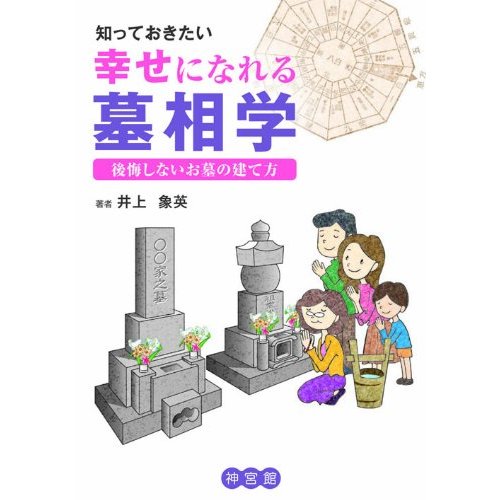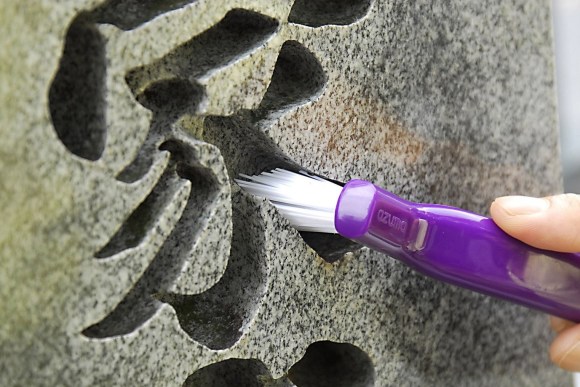
This Thursday, 15 August marks the beginning of Obon in most of Japan. Obon is a Buddhist custom in Japan where families gather together and are visited by the spirits of their ancestors. Various festivals are held to welcome the ghosts with music and dancing, depending on the region.
However, one tradition that is fairly consistent across the country is known as Ohakamairi (visiting the grave). This custom involves the family going to their grave to clean it and give presents to their deceased ancestors.
Since the majority of people in Japan are cremated after death, family lines tend to share a grave traditionally passed down to the oldest son of the family. In addition, the main home of a family usually has an altar of sorts (known as a bustudan) to pray to their ancestors.
During Obon the spirits of these ancestors are said to enter the realm of the living. The living family’s responsibility is to welcome them by cleaning the grave, giving presents, and lighting incense or building very small fires outside the home to guide them.
When you arrive at the temple where the grave is located you can usually borrow a bucket of water, but you may need to bring your own cloths to wipe it down with. While soaking the rag in the water it’s time to pick up any litter that happens to be around and pull out weeds from the surrounding area.
The rag should be wrung out strongly before wiping the grave with it. Many people pour the water over top of the grave, but Misa Kasuga of the website Happism maintains that this is a faux pas, saying that this is offensive to the spirits of our ancestors, and is like splashing a living person over the head with a bucket of cold water.
When the grave is nice and shiny then the fresh flowers can be arranged. Special types of flowers are preferred for graves called bukka (lit. Buddha flowers). They are usually mild in color and scent and are often prepared by the temple. Chrysanthemums are the most popular choices, but it’s also fine to use any flower that the deceased particularly liked. Many graves have built-in holders for the flowers.
Next comes the incense. An entire bundle of sticks should be lit to produce a decent amount of smoke according to Ms. Kasuga. This smoke is said to ward off other spirits that don’t have any family of their own to take care of their grave (known as moenbotoke) and try to muscle in on yours.
After lighting the incense you should press your hands together to say thanks to your ancestors for helping bring you into the world and ask that they continue to watch over the family and offer guidance and protection. When all is said and done you give a bow and get ready to leave.
During the lighting of the incense you might have laid out an offering, usually something a recently deceased person used to like. Walking around a cemetery you’ll usually see cans of coffee, beer, or sake sitting out, possibly even various snacks.
When the grave visit is finished you can do whatever you want with the present, you can even take it back home or consume it yourself. Much like with the living, it’s the thought that counts. Many people simply leave the gift sitting on the grave, but temple staff doesn’t really appreciate this as they ultimately have to take care of it, so try to be considerate and come back for it later if you want to leave it for a while. If I suddenly find myself homeless and hungry though, I know exactly where go…
Before heading home, you must return the bucket and empty out the excess water. Ms. Kasuga again points out that you shouldn’t pour the water near the grave either, as there is usually poor drainage and the moisture can cause the grave to weather more quickly.
If all goes well then you should be accompanied home by the pleased ghosts of your ancestors! As spooky as that might seem, at least they don’t complain and eat all your food.
Happy Obon, everyone!
Source: Happism (Japanese)
Top Image: Amazon
Inset Images: Amazon 1, 2



 The unusual and surprising ways people in Nagasaki celebrate Obon, the festival of spirits
The unusual and surprising ways people in Nagasaki celebrate Obon, the festival of spirits First-ever Bon-Odori dance festival to be held at Shibuya scramble crossing for Obon
First-ever Bon-Odori dance festival to be held at Shibuya scramble crossing for Obon Japanese taxi company offers service to visit family graves for those who can’t travel themselves
Japanese taxi company offers service to visit family graves for those who can’t travel themselves Fireworks, seaweed, and sake-The unique regional aspects of visiting a grave in Japan
Fireworks, seaweed, and sake-The unique regional aspects of visiting a grave in Japan Five things you need to know about Obon–one of Japan’s biggest holidays 【Videos & more】
Five things you need to know about Obon–one of Japan’s biggest holidays 【Videos & more】 Japanese beef bowl chain Sukiya’s 2026 Smile Box lucky bag basically pays for itself
Japanese beef bowl chain Sukiya’s 2026 Smile Box lucky bag basically pays for itself New Japanese menstrual product seeks to help women spot unidentified iron deficiencies
New Japanese menstrual product seeks to help women spot unidentified iron deficiencies Play games, learn, and get your fortune at Ginza’s limited-time Tsunaguu “Shrine of the Future”
Play games, learn, and get your fortune at Ginza’s limited-time Tsunaguu “Shrine of the Future” Starbucks Japan ready to get Year of the Horse started with adorable drinkware and plushies【Pics】
Starbucks Japan ready to get Year of the Horse started with adorable drinkware and plushies【Pics】 7-Eleven Japan has a hack for creating insanely delicious potato chip rice meals
7-Eleven Japan has a hack for creating insanely delicious potato chip rice meals Busty Japanese brushstroke calligraphy artist shares visual appeal in video series【Videos】
Busty Japanese brushstroke calligraphy artist shares visual appeal in video series【Videos】 Pizza Hut Japan’s hot lucky bags are perfect for a New Year’s pizza party
Pizza Hut Japan’s hot lucky bags are perfect for a New Year’s pizza party 8 sakura sweets to enjoy under the cherry blossoms at your next hanami picnic in Japan
8 sakura sweets to enjoy under the cherry blossoms at your next hanami picnic in Japan Is real Tokyo as dangerous as the Yakuza video games? Chapter 3: Crazy Town
Is real Tokyo as dangerous as the Yakuza video games? Chapter 3: Crazy Town Get ready for a cherry-blossom-flavored spring with Sakura Butter potato chips from Calbee!
Get ready for a cherry-blossom-flavored spring with Sakura Butter potato chips from Calbee! 7 great places to see Mt. Fuji from without having to climb it
7 great places to see Mt. Fuji from without having to climb it Cyberpunk anime meets traditional culture in Ghost in the Shell gold leaf Japanese changing screens
Cyberpunk anime meets traditional culture in Ghost in the Shell gold leaf Japanese changing screens Hayao Miyazaki says Happy New Year to Studio Ghibli fans with new art for Year of the Horse
Hayao Miyazaki says Happy New Year to Studio Ghibli fans with new art for Year of the Horse Hello Kitty Choco Egg figures are an adorable trip through three periods of Japanese pop culture【Pics】
Hello Kitty Choco Egg figures are an adorable trip through three periods of Japanese pop culture【Pics】 We found possibly the quietest Japanese-style hotel in Tokyo’s bustling Shinjuku district
We found possibly the quietest Japanese-style hotel in Tokyo’s bustling Shinjuku district 7-Eleven Japan’s ramen-cooking robot whipped us up a bowl of noodles【Taste test】
7-Eleven Japan’s ramen-cooking robot whipped us up a bowl of noodles【Taste test】 Sumo Sanrio! Hello Kitty and pals team up with Japan Sumo Association for new merch【Pics】
Sumo Sanrio! Hello Kitty and pals team up with Japan Sumo Association for new merch【Pics】 Japan’s oldest largetooth sawfish in captivity back on display in Mie Prefecture
Japan’s oldest largetooth sawfish in captivity back on display in Mie Prefecture More Than a Capsule Stay: Why Solo Travelers Choose “global cabin Yokohama Chinatown”
More Than a Capsule Stay: Why Solo Travelers Choose “global cabin Yokohama Chinatown” 7-Eleven Japan starts new temporary luggage storage service in over 300 branches
7-Eleven Japan starts new temporary luggage storage service in over 300 branches Disillusionment at Tsukiji’s tourist-target prices led us to a great ramen restaurant in Tokyo
Disillusionment at Tsukiji’s tourist-target prices led us to a great ramen restaurant in Tokyo Starbucks teams up with 166-year-old Kyoto doll maker for Year of the Horse decorations【Photos】
Starbucks teams up with 166-year-old Kyoto doll maker for Year of the Horse decorations【Photos】 Tokyo considering law requiring more trash cans following litter increase in heavily touristed area
Tokyo considering law requiring more trash cans following litter increase in heavily touristed area Tokyo’s Tsukiji sushi neighborhood asks tour groups to stay away for the rest of the month
Tokyo’s Tsukiji sushi neighborhood asks tour groups to stay away for the rest of the month Tokyo event lets you travel back in time, for free, to celebrate 100 years since Showa era start
Tokyo event lets you travel back in time, for free, to celebrate 100 years since Showa era start Sanrio theme park in Japan announces plans to expand into a Sanrio resort
Sanrio theme park in Japan announces plans to expand into a Sanrio resort Japan may add Japanese language proficiency, lifestyle classes to permanent foreign resident requirements
Japan may add Japanese language proficiency, lifestyle classes to permanent foreign resident requirements Stamina-destroying “Paralysis Noodles” are Tokyo’s newest over-the-top ramen innovation
Stamina-destroying “Paralysis Noodles” are Tokyo’s newest over-the-top ramen innovation Survey asks foreign tourists what bothered them in Japan, more than half gave same answer
Survey asks foreign tourists what bothered them in Japan, more than half gave same answer Japan’s human washing machines will go on sale to general public, demos to be held in Tokyo
Japan’s human washing machines will go on sale to general public, demos to be held in Tokyo Japan’s deadliest food claims more victims, but why do people keep eating it for New Year’s?
Japan’s deadliest food claims more victims, but why do people keep eating it for New Year’s? We deeply regret going into this tunnel on our walk in the mountains of Japan
We deeply regret going into this tunnel on our walk in the mountains of Japan Studio Ghibli releases Kodama forest spirits from Princess Mononoke to light up your home
Studio Ghibli releases Kodama forest spirits from Princess Mononoke to light up your home Major Japanese hotel chain says reservations via overseas booking sites may not be valid
Major Japanese hotel chain says reservations via overseas booking sites may not be valid Put sesame oil in your coffee? Japanese maker says it’s the best way to start your day【Taste test】
Put sesame oil in your coffee? Japanese maker says it’s the best way to start your day【Taste test】 No more using real katana for tourism activities, Japan’s National Police Agency says
No more using real katana for tourism activities, Japan’s National Police Agency says Starbucks Japan reveals new sakura drinkware collection, inspired by evening cherry blossoms
Starbucks Japan reveals new sakura drinkware collection, inspired by evening cherry blossoms Updated cherry blossom forecast shows extra-long sakura season for Japan this year
Updated cherry blossom forecast shows extra-long sakura season for Japan this year How Japanese people deal with death at Nagasaki’s Shoro Nagashi ceremony
How Japanese people deal with death at Nagasaki’s Shoro Nagashi ceremony Why a Nagasaki graveyard is one of the best places in Japan to find a seat
Why a Nagasaki graveyard is one of the best places in Japan to find a seat The top 11 Japanese summer festivals, according to travellers
The top 11 Japanese summer festivals, according to travellers
Leave a Reply